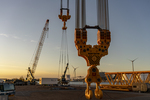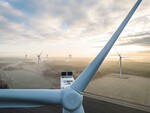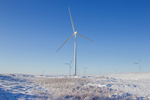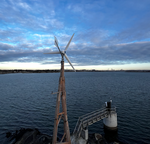11/27/2010
Product Pick of the Week - GeoSea: New technology drives down turbine foundation installation costs
GeoSea, the pre-piling pioneer, has taken strides to achieve cost competitive foundation installation. Wind Energy Update speaks to GeoSea's project manager Niels van Berlaer, to learn more about the proprietary technologies and smart designs that are chipping away the cost of offshore wind.
If it is turbine foundations you need installed, Niels van Berlaer is a man you should speak to. Project manager on the first ever pre-piling jacket installation project for the Alpha Ventus wind farm, Mr van Berlaer and his company, GeoSea, have more experience than most out there today.
The proving ground for jacket installation was this year’s project for the Ormonde offshore wind farm, where 31 jackets were installed between April and October. During this year’s installation, GeoSea, (part of the Belgian Deme Group), brought into play several novel technologies developed off the back of its Alpha Ventus experience, to speed the process.
Having proven that jacket foundations can be installed quickly and cost competitively, developers are now queuing up for GeoSea’s services. Next month, GeoSea will drive 14 test piles into Kriegers Flak in preparation for the installation of 80 turbine foundations – 40 monopiles, and 40 pre-piles – in 2012.
The company will also be installing 49 jacket foundations the on Thornton Bank Offshore Wind Farm Phase 2 & 3 project 2011 and 2012, and will also begin pre-piling for tripod installation on the Borkum West II wind farm, in August 2011.
Wind Energy Update speaks to project manager Niels van Berlaer to find out how GeoSea cut the complexity and cost out of pre-piling.
Wind Energy Update: GeoSea has extensive experience in installing turbine foundations and turbines in the offshore wind sector. In your view, which foundations present the fewest logistical hurdles?
Niels van Berlaer: This summer we worked on the Walney and Ormonde wind farms. On Walney, GeoSea installed monopiles; and on Ormonde, we installed jackets.
The installation times for the two projects were quite similar, but the techniques are completely different. Monopiles are a good system. They require larger diameter piles (of around 5 metres), which present a logistical challenge.
Pre-piles on the other hand have a smaller diameter (of around 1.8 metres). The larger diameter of monopiles means that it is more complicated to handle them; you need bigger cranes and bigger piling hammers to drive them.
With jackets, however, you need four piles per foundation and more lifts are involved. Installation of jackets can be done by two different techniques. You have pre-piling and post-piling.
Post piling implies a higher cost than pre-piling, due to the fact that you have the same cost for the jacket installation as for the piling operation. These operations are done from the same heavy lift vessel.
For pre-piling however, one can use a less expensive pre-piling spread - which just requires a jack up platform to install the foundation piles. The jacket installation can be done from a different heavy lift spread, which does not have any downtime due to the piling operations. The heavy lift vessel only has to do what it is meant for; the heavy lifts. Therefore pre-piling is a smart approach.
Monopile installation needs big installation vessels and transport vessels for the transition pieces. You also need a shear leg (heavy lift vessel) to up-end the big monopiles. So you are talking about a lot of marine equipment.
If I were to choose, I would advise pre-piling. I think that clients have been very satisfied with the system and they are looking to use it again on future projects. We are still fine-tuning the method of pre-piling, so there is room to further improve the process.
Wind Energy Update: What are the advantages and drawbacks of gravity-base foundations?
Niels van Berlaer: One of their advantages is that, of all the foundation options, they have the least environmental impact, given that they do not require piling. All other foundation installation requires piling, which creates a lot of noise impact for sea mammals.
But gravity based foundations are by far the most expensive and are very challenging from a logistical perspective. They are probably the most complex foundation to work with, given that they weigh around 3000 tonnes, which requires the use of specialist vessels. Jackets, by contrast, weigh roughly 500 tonnes.
For gravity based foundations, you need to float the foundations to site. Before they are positioned, you need to level the seabed and lay the scouring.
Once installed, you then need to fill the gravity based foundation up with sand, which requires specialist machinery. A specific vessel, named ‘Thornton 1’,was designed for the first phase of the Thornton Bank Offshore Wind Farm. This vessel, equipped with a mooring system, pumps sand hydraulically into the gravity based foundation.
Wind Energy Update: What lessons were taken from your experience with pre-piling on the Alpha Ventus jacket foundation installation and how did you apply those lessons to Ormonde?
Niels van Berlaer: Some very good lessons were taken from Alpha Ventus, which enabled us to carry out the pre-piling and foundation installation on Ormonde much faster.
Pre-piling was done for the first time ever on the Alpha Ventus project. There were only 6 foundations and we used two different seabed templates to install them. At the time it was the only equipment available.
It was actually designed for deep water installations, related to the oil industry, so it was the first time that it has ever been used in the wind industry at shallow water depths. This specific installation method was very complex for several reasons.
The two large and heavy templates had to be stored on deck, thus creating a congested work area.
The difficulty of the templates was that the smaller centre frame required fixation with two temporary driven pin-piles, while the larger second template would have to be moved 4 times under water for each corner of the actual jacket.
For the Ormonde project, by reducing the two frames to one, we cut out a lot of offshore lifting operations and almost all ROV operations, which saved considerable installation time. It is about 6 times faster to install jackets with the single frame template.
The problem, however, is that the frame is so big – it’s about 20 x 20 metres, weighing 160 tonnes in the air. You cannot actually fit it on the deck, so we slung it under the jack up platform, which has never been done before.
We slung it beneath the jack up platform in such a way so that when it is lowered to the sea bed, we are able to up-end the piles and install the four piles into the template and hammer them all to target depth from one single jack up platform location.
This contrasts with the Alpha Ventus project, where we had to reposition the jack up platform twice for each location.
Wind Energy Update: GeoSea has developed a system to monitor pile driving, without the use of expensive ROVs. Can you explain the system and provide some idea of the time and cost savings it delivers on jacket installation?
Niels van Berlaer: We can drive the piles very accurately by a monitoring system we have invented and patented, which uses a simple taut wire system. It’s a very clever, yet simple system to monitor the driving depth from the jack up platform during the driving itself. It enables us also to monitor the driving of one pile relative to another very accurately.
The industry requires the piles to be driven within a range of +/- 200mm relative to each other. Our system can do this and more. Because the jacket fabricator needs to adjust the jacket to the piles once they are installed, this level of accuracy reduces any cost associated with jacket adaptations, so-called shimming, to the piles.
Another cost saving is that it removes the need for ROVs. The traditional method of measuring accuracy involves using ROVs to measure throughout the pile driving. This means you have to stop driving several times in order for the ROV to take the measurements, which increases the time and man-hours.
ROVs also imply procurement issues and they are not always operational. Another issue is that sometimes you have to wait a significant amount of hours for the right current window for the ROV to operate in. The overall objective was to eliminate expensive equipment like ROVs, which also rely on a lot of people to handle it.
Wind Energy Update: GeoSea is bringing new vessels into play that can be used on farshore, deepwater wind farms. Can you provide some more details on these vessels and why you think jack ups are better equipped for foundation and turbine installation?
Niels van Berlaer: Currently we have seven jack-ups and we are building a new one at the moment. The biggest has spuds of 88 metres, which are extendable to 92 metres.
Jack-ups are stable. Other installation vessels struggle with weather conditions and swell, whereas jack-up vessels operate above the swell. It is easy to operate a crane on a fixed jack up platform, because it provides a stable base for the crane
Until now, all the jack-up vessels are not self-propelled, so have always needed a tug. Now, we are building a new jack-up and we are refitting an existing jack-up to a self-propelled DP2 vessel. Both jack-ups will be fitted with a fixed offshore crane, so if any of our clients are interested in equipment, by 2011 we will have self-propelled DP2 jack up platforms, equipped with a crane which has a lifting capacity of 600 tonnes at 26 meter radius.
The new build, which has legs of up to 92 metres, is called Neptune, and will be operational in 2011.
For more information on this article or if you would like to know more about what www.windfair.net can offer, please do not hesitate to contact Trevor Sievert at ts@windfair.net
www.windfair.net is the largest international B2B Internet platform – ultimately designed for connecting wind energy enthusiasts and companies across the globe!
If it is turbine foundations you need installed, Niels van Berlaer is a man you should speak to. Project manager on the first ever pre-piling jacket installation project for the Alpha Ventus wind farm, Mr van Berlaer and his company, GeoSea, have more experience than most out there today.
The proving ground for jacket installation was this year’s project for the Ormonde offshore wind farm, where 31 jackets were installed between April and October. During this year’s installation, GeoSea, (part of the Belgian Deme Group), brought into play several novel technologies developed off the back of its Alpha Ventus experience, to speed the process.
Having proven that jacket foundations can be installed quickly and cost competitively, developers are now queuing up for GeoSea’s services. Next month, GeoSea will drive 14 test piles into Kriegers Flak in preparation for the installation of 80 turbine foundations – 40 monopiles, and 40 pre-piles – in 2012.
The company will also be installing 49 jacket foundations the on Thornton Bank Offshore Wind Farm Phase 2 & 3 project 2011 and 2012, and will also begin pre-piling for tripod installation on the Borkum West II wind farm, in August 2011.
Wind Energy Update speaks to project manager Niels van Berlaer to find out how GeoSea cut the complexity and cost out of pre-piling.
Wind Energy Update: GeoSea has extensive experience in installing turbine foundations and turbines in the offshore wind sector. In your view, which foundations present the fewest logistical hurdles?
Niels van Berlaer: This summer we worked on the Walney and Ormonde wind farms. On Walney, GeoSea installed monopiles; and on Ormonde, we installed jackets.
The installation times for the two projects were quite similar, but the techniques are completely different. Monopiles are a good system. They require larger diameter piles (of around 5 metres), which present a logistical challenge.
Pre-piles on the other hand have a smaller diameter (of around 1.8 metres). The larger diameter of monopiles means that it is more complicated to handle them; you need bigger cranes and bigger piling hammers to drive them.
With jackets, however, you need four piles per foundation and more lifts are involved. Installation of jackets can be done by two different techniques. You have pre-piling and post-piling.
Post piling implies a higher cost than pre-piling, due to the fact that you have the same cost for the jacket installation as for the piling operation. These operations are done from the same heavy lift vessel.
For pre-piling however, one can use a less expensive pre-piling spread - which just requires a jack up platform to install the foundation piles. The jacket installation can be done from a different heavy lift spread, which does not have any downtime due to the piling operations. The heavy lift vessel only has to do what it is meant for; the heavy lifts. Therefore pre-piling is a smart approach.
Monopile installation needs big installation vessels and transport vessels for the transition pieces. You also need a shear leg (heavy lift vessel) to up-end the big monopiles. So you are talking about a lot of marine equipment.
If I were to choose, I would advise pre-piling. I think that clients have been very satisfied with the system and they are looking to use it again on future projects. We are still fine-tuning the method of pre-piling, so there is room to further improve the process.
Wind Energy Update: What are the advantages and drawbacks of gravity-base foundations?
Niels van Berlaer: One of their advantages is that, of all the foundation options, they have the least environmental impact, given that they do not require piling. All other foundation installation requires piling, which creates a lot of noise impact for sea mammals.
But gravity based foundations are by far the most expensive and are very challenging from a logistical perspective. They are probably the most complex foundation to work with, given that they weigh around 3000 tonnes, which requires the use of specialist vessels. Jackets, by contrast, weigh roughly 500 tonnes.
For gravity based foundations, you need to float the foundations to site. Before they are positioned, you need to level the seabed and lay the scouring.
Once installed, you then need to fill the gravity based foundation up with sand, which requires specialist machinery. A specific vessel, named ‘Thornton 1’,was designed for the first phase of the Thornton Bank Offshore Wind Farm. This vessel, equipped with a mooring system, pumps sand hydraulically into the gravity based foundation.
Wind Energy Update: What lessons were taken from your experience with pre-piling on the Alpha Ventus jacket foundation installation and how did you apply those lessons to Ormonde?
Niels van Berlaer: Some very good lessons were taken from Alpha Ventus, which enabled us to carry out the pre-piling and foundation installation on Ormonde much faster.
Pre-piling was done for the first time ever on the Alpha Ventus project. There were only 6 foundations and we used two different seabed templates to install them. At the time it was the only equipment available.
It was actually designed for deep water installations, related to the oil industry, so it was the first time that it has ever been used in the wind industry at shallow water depths. This specific installation method was very complex for several reasons.
The two large and heavy templates had to be stored on deck, thus creating a congested work area.
The difficulty of the templates was that the smaller centre frame required fixation with two temporary driven pin-piles, while the larger second template would have to be moved 4 times under water for each corner of the actual jacket.
For the Ormonde project, by reducing the two frames to one, we cut out a lot of offshore lifting operations and almost all ROV operations, which saved considerable installation time. It is about 6 times faster to install jackets with the single frame template.
The problem, however, is that the frame is so big – it’s about 20 x 20 metres, weighing 160 tonnes in the air. You cannot actually fit it on the deck, so we slung it under the jack up platform, which has never been done before.
We slung it beneath the jack up platform in such a way so that when it is lowered to the sea bed, we are able to up-end the piles and install the four piles into the template and hammer them all to target depth from one single jack up platform location.
This contrasts with the Alpha Ventus project, where we had to reposition the jack up platform twice for each location.
Wind Energy Update: GeoSea has developed a system to monitor pile driving, without the use of expensive ROVs. Can you explain the system and provide some idea of the time and cost savings it delivers on jacket installation?
Niels van Berlaer: We can drive the piles very accurately by a monitoring system we have invented and patented, which uses a simple taut wire system. It’s a very clever, yet simple system to monitor the driving depth from the jack up platform during the driving itself. It enables us also to monitor the driving of one pile relative to another very accurately.
The industry requires the piles to be driven within a range of +/- 200mm relative to each other. Our system can do this and more. Because the jacket fabricator needs to adjust the jacket to the piles once they are installed, this level of accuracy reduces any cost associated with jacket adaptations, so-called shimming, to the piles.
Another cost saving is that it removes the need for ROVs. The traditional method of measuring accuracy involves using ROVs to measure throughout the pile driving. This means you have to stop driving several times in order for the ROV to take the measurements, which increases the time and man-hours.
ROVs also imply procurement issues and they are not always operational. Another issue is that sometimes you have to wait a significant amount of hours for the right current window for the ROV to operate in. The overall objective was to eliminate expensive equipment like ROVs, which also rely on a lot of people to handle it.
Wind Energy Update: GeoSea is bringing new vessels into play that can be used on farshore, deepwater wind farms. Can you provide some more details on these vessels and why you think jack ups are better equipped for foundation and turbine installation?
Niels van Berlaer: Currently we have seven jack-ups and we are building a new one at the moment. The biggest has spuds of 88 metres, which are extendable to 92 metres.
Jack-ups are stable. Other installation vessels struggle with weather conditions and swell, whereas jack-up vessels operate above the swell. It is easy to operate a crane on a fixed jack up platform, because it provides a stable base for the crane
Until now, all the jack-up vessels are not self-propelled, so have always needed a tug. Now, we are building a new jack-up and we are refitting an existing jack-up to a self-propelled DP2 vessel. Both jack-ups will be fitted with a fixed offshore crane, so if any of our clients are interested in equipment, by 2011 we will have self-propelled DP2 jack up platforms, equipped with a crane which has a lifting capacity of 600 tonnes at 26 meter radius.
The new build, which has legs of up to 92 metres, is called Neptune, and will be operational in 2011.
For more information on this article or if you would like to know more about what www.windfair.net can offer, please do not hesitate to contact Trevor Sievert at ts@windfair.net
www.windfair.net is the largest international B2B Internet platform – ultimately designed for connecting wind energy enthusiasts and companies across the globe!
- Source:
- Geosea
- Author:
- Posted by Trevor Sievert, Online Editorial Journalist / Author Rikki Stancich
- Email:
- ts@windfair.net
- Link:
- www.windfair.net/...
- Keywords:
- wind energy, wind power, wind turbine, onshore, offshore, windmill, www.windfair.net, Trevor Sievert, ECA


























